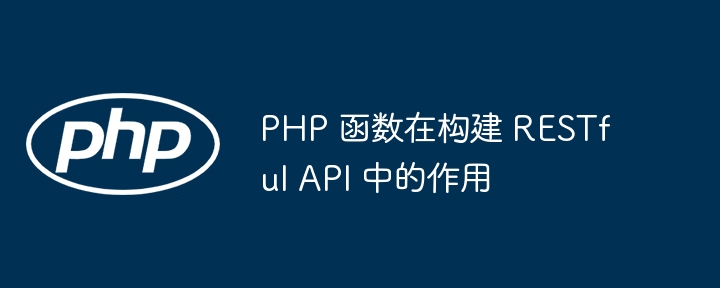The role of PHP functions in building RESTful APIs
PHP provides a set of functions for building RESTful APIs that simplify the process of handling requests, parsing data, and generating responses. These functions include: processing request: $_SERVER['REQUEST_METHOD'] (get the request method), file_get_contents('php://input') (get the request body) data parsing: json_decode() (parse the JSON string into a PHP array ), parse_url() (parse URL) response generation: header() (send HTTP header), http_response_code() (set HTTP response code), echo or print (output response body)

The role of PHP functions in building RESTful API
When building a RESTful API in PHP, you can use various functions to simplify the development process. These functions make development more efficient by providing the tools needed to handle requests, parse data, and generate responses.
Methods to handle requests:
-
$_SERVER['REQUEST_METHOD']: Get the request method (GET, POST, PUT wait). -
file_get_contents('php://input'): Get the request body.
Data parsing function:
-
json_decode(): Parse JSON string into PHP array or object. -
parse_url(): Parse the URL and extract query parameters and path information.
Response generation function:
-
header(): Send HTTP header. -
http_response_code(): Set HTTP response code. -
echoorprint: Output the response body.
Practical Example: Creating a Simple GET Request API
Suppose we want to create an API endpoint for our blog to get a collection of all blog posts. The following code can be used:
<?php
// 处理 GET 请求
if ($_SERVER['REQUEST_METHOD'] === 'GET') {
// 获取数据库中所有博客文章
$articles = get_all_articles();
// 编码为 JSON 格式
$json = json_encode($articles);
// 发送响应
header('Content-Type: application/json');
http_response_code(200);
echo $json;
}In this example:
-
$_SERVER['REQUEST_METHOD']Checks if the request is a GET. -
get_all_articles()Custom function to retrieve articles from the database. -
json_encode()Encode an array into a JSON string. -
header()andhttp_response_code()Set the HTTP response header and code. -
echoOutputs the JSON response body.
By leveraging PHP functions, we can easily build powerful RESTful APIs that simplify interaction with front-end applications and other services.
The above is the detailed content of The role of PHP functions in building RESTful APIs. For more information, please follow other related articles on the PHP Chinese website!

Hot AI Tools

Undresser.AI Undress
AI-powered app for creating realistic nude photos

AI Clothes Remover
Online AI tool for removing clothes from photos.

Undress AI Tool
Undress images for free

Clothoff.io
AI clothes remover

AI Hentai Generator
Generate AI Hentai for free.

Hot Article

Hot Tools

Notepad++7.3.1
Easy-to-use and free code editor

SublimeText3 Chinese version
Chinese version, very easy to use

Zend Studio 13.0.1
Powerful PHP integrated development environment

Dreamweaver CS6
Visual web development tools

SublimeText3 Mac version
God-level code editing software (SublimeText3)

Hot Topics
 CakePHP Project Configuration
Sep 10, 2024 pm 05:25 PM
CakePHP Project Configuration
Sep 10, 2024 pm 05:25 PM
In this chapter, we will understand the Environment Variables, General Configuration, Database Configuration and Email Configuration in CakePHP.
 PHP 8.4 Installation and Upgrade guide for Ubuntu and Debian
Dec 24, 2024 pm 04:42 PM
PHP 8.4 Installation and Upgrade guide for Ubuntu and Debian
Dec 24, 2024 pm 04:42 PM
PHP 8.4 brings several new features, security improvements, and performance improvements with healthy amounts of feature deprecations and removals. This guide explains how to install PHP 8.4 or upgrade to PHP 8.4 on Ubuntu, Debian, or their derivati
 CakePHP Date and Time
Sep 10, 2024 pm 05:27 PM
CakePHP Date and Time
Sep 10, 2024 pm 05:27 PM
To work with date and time in cakephp4, we are going to make use of the available FrozenTime class.
 CakePHP File upload
Sep 10, 2024 pm 05:27 PM
CakePHP File upload
Sep 10, 2024 pm 05:27 PM
To work on file upload we are going to use the form helper. Here, is an example for file upload.
 CakePHP Routing
Sep 10, 2024 pm 05:25 PM
CakePHP Routing
Sep 10, 2024 pm 05:25 PM
In this chapter, we are going to learn the following topics related to routing ?
 Discuss CakePHP
Sep 10, 2024 pm 05:28 PM
Discuss CakePHP
Sep 10, 2024 pm 05:28 PM
CakePHP is an open-source framework for PHP. It is intended to make developing, deploying and maintaining applications much easier. CakePHP is based on a MVC-like architecture that is both powerful and easy to grasp. Models, Views, and Controllers gu
 CakePHP Creating Validators
Sep 10, 2024 pm 05:26 PM
CakePHP Creating Validators
Sep 10, 2024 pm 05:26 PM
Validator can be created by adding the following two lines in the controller.
 CakePHP Working with Database
Sep 10, 2024 pm 05:25 PM
CakePHP Working with Database
Sep 10, 2024 pm 05:25 PM
Working with database in CakePHP is very easy. We will understand the CRUD (Create, Read, Update, Delete) operations in this chapter.






